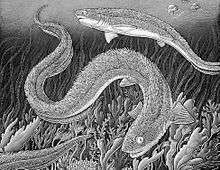Listracanthus
Listracanthus is a genus of extinct chondrichthyan with uncertain affinities. Species of Listracanthus are known primarily from their tremendous, feather-like denticles, which range up to four inches in length. The denticles had a large main spine, from which secondary spines emanate from the sides, like the barbs of a feather or a comb. Listracanthus first appeared in late Carboniferous strata in North America, and eventually disappear from the fossil record some time during the Early Triassic.[1]

| Listracanthus | |
|---|---|
| Life reconstruction of Listracanthus hystrix | |
| Scientific classification | |
| Kingdom: | Animalia |
| Phylum: | Chordata |
| Class: | Chondrichthyes |
| Genus: | †Listracanthus Newberry & Worthen, 1870 |
| Species[1] | |
| |
The appearance of these sharks are largely unknown. However, author and illustrator Ray Troll mentions in his book, Sharkabet, about how paleontologist Rainer Zangerl once discovered a large shale slab containing a long, eel-like fish covered in long, spine-like denticles characteristic of the genus, only to have it dry out and crumble into dust. As such, according to Zangerl's account, Troll reconstructs Listracanthus as resembling a tremendous, fiercely bristled frill shark.[3]
References
- Mutter, R.J.; Neuman, A.G. "An enigmatic chondrichthyan with Paleozoic affinities from the Lower Triassic of western Canada". Acta Palaeontologica Polonica. 51 (2): 271–282.
- Listracanthus on the Paleobiology Database
- Ray Troll (2002). Sharkabet: A Sea of Sharks from A to Z. Westwinds Press, ISBN 1558685197